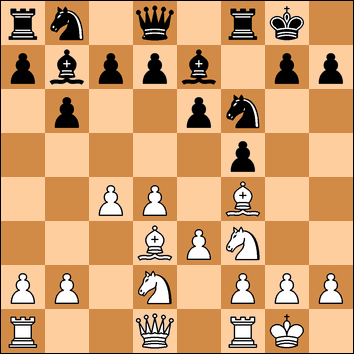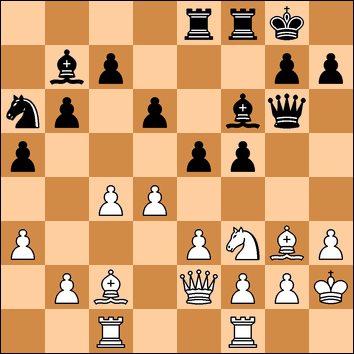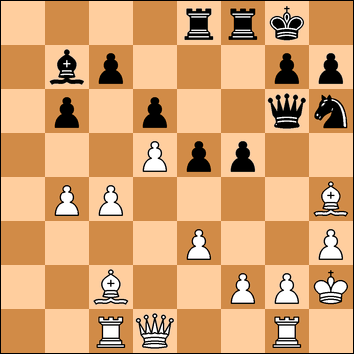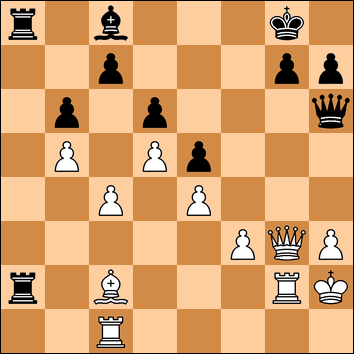Monday 27 March 2017
White: D. Warrick (108) - Black: K. Nevols (134)
I was called in as an emergency substitute for my fourth game for Rochester, this time back at Cranbrook Library. Having been held up by traffic. I got there with minutes to spare and was surprised to find the entire Rochester team was made up of Swale players!! Without a chance to question this surprising turn of events I seated and the game began.
1. d4 f5
Another chance to try out the Dutch. Results so far were not too bad.
2. Nf3 e6
3. Bf4
Like my last game, my opponent delays c4.
3. ... Nf6
4. e3 Be7
5. Bd3 b6
And this time I remember the advice. If White does not fianchetto his bishop on the h1-a8 diagonal then Black should do so.
The computer now recommends 6. Ne5 and replies to 6. .. d6 with 7. Qf3 forcing 7. .. d5 and White gets tied up in knots. (8. Bb5+ Kf8 or 8. .. Bd7 9. Nxd7 Nfxd7 10. Qg3 ... or 9. ...Nbxd7 10. Bc6).
Black should reply to 6. Ne5 with 6. .. Bb7. But White continues development.
6. Nbd2 Bb7
7. O-O O-O
8. c4

The computer recommends 8. h3 as it thinks that Black can now exchange the bishop and gain an advantage with 8. .. Nh5 9. Bg3 Nxg3 10. hxg3 g5. I did not see this possibility and instead decide to develop the queenside.
8. .. a5
9. Rc1 Na6
To defend the c7 point in preparation for moving the queen.
10. a3 Qe8
11. h3 Ne4
12. Qc2 Nxd2
13. Qxd2 Qg6
I was quite comfortable with my position here. White still can't play e4 and is unable to advance anywhere.
14. Bg3 d6
Keeping the white knight out of the e5 square and preparing to advance the centre pawns.
15. Qe2 Bf6
16. Kh2 e5
17. Bc2 Rae8

Now 18. c5!? is interesting with 18. .. bxc5 19. Qb5. White has possibilities such as Qxa5 or dxe5 dxe5; Bb3+ opening up on the doubled c-pawns.
Black's best might be 19. .. Bc8 then 20. dxe5 dxe5 21. Bb3+ Kh8 22. Qxa5 and then it depends on whether he sees 22. .. f4! 23. exf4 exf4 24. Bxf4 Bxb2 25. Rc2 Rxf4 26. Rxb2 Bxh3 27. gxh3 Rxf3.
So perhaps then 20. dxe5 dxe5 21. Qxa5 leaving the f-pawn pinned. Black might then play 21. .. e4 exploiting the fact that the pawn on b2 is undefended. One line could be 22. Nh4 Qh6! 23.Nxf5 Qg6 24. Bb3+ Kh8 25. Bc4 Qxf5 26. Bxa6 Bxa6 27. Qxa6 Bxb2 28. Rc2 Be5.
Instead White decides not to engage in complications and just moves the queen off the e-file.
18. Qd1
Now I considered 18. .. h5 gaining more space and threatening h4 but decided against it as I did not want a pawn on its own which I would have to defend. So instead I bring the knight into the battle. This however is a waste of time and allows White to gain space.
18. .... Nb8
19. Rg1 Nc6
20. d5 Nd8?
This is a mistake. White can now get a big advantage with 21. Ba4! Re7 22. Nh4 Nxh4 23. Bxh4 Ref7 24.f4!
Look at the position now - White's bishops are well placed, Black's knight and rooks have literally no moves, and Black's other pieces are not happier.
Black should have played 20. . Ne7. Then 21. Ba4 Rd8.
Fortunately White does not spot the opportunity and decides to open the a-file. I note that, as it could come in useful (and indeed it does!)
21. b4 axb4
22. axb4 Nf7
Now it is White's turn to make a mistake. He should take the second opportunity to play 23. Ba4.
23. Nh4? Bxh4
24. Bxh4 Nh6??
But Black does not spot it. 24. .. Qh6 wins a piece. 25. Bg3 f4.
I completely overlooked this and was concentrating on advancing the knight and defending the f5 pawn.

I was not happy with the position now. I had taken five moves to get the knight from one edge of the board to the other! White's bishops were looking good, and a well-timed g4 from White could put my king in jeopardy. The only thing I could do was to grab the a-file.
The computer does indeed now recommend 25. g4! keeping Black on the wrong foot. Black can't play 25. .. Qf7 because of 26. g5 and so has to play 26. .. e4 then 27. gxf5 Qxf5 28. f4! and White could now put the g-file to good use and, long term, try to play Bd1-c3.
25. Qe2 Qf7
26. Bd1?!
I did not understand these moves but was grateful for the chance to grab the a-file. The bishop blocks the communication between the two rooks.
26. .... Ra8!
27. b5 Ra5
28. f3 Rfa8
Again 29. g4 puts Black under pressure (29. .. Ra2 30. Rc2) but instead White makes the puzzling decision to exchange off one of his good bishops.
29. Bg5 Qg6
30. Bxh6?! Qxh6
31. Bc2 Bc8
At last the bishop has the chance to get back into the game.
32. Qf2 Ra3
33. e4 f4
Missing the chance to put White under pressure with 33. .. Rc3 and closing the h6-c1 diagonal. But my plan was to sac on h3 if I got the chance.
34. g4?
I thanked the heavens. This move would have been so good earlier but now it is a mistake. Lines open up against the white king.
34. ... fxg3 e.p.
35. Qxg3 Ra2
Again missing the chance for Rc3. White should now play 36. h4.
36. Rg2

While White was thinking I saw this move and that it would be a mistake. I now gave some thought into various combinations - the danger was whether White could force perpetual check. Having decided he could not, the second danger was whether I had overlooked anything. Combinations are not really my thing. Eventually I decided I had to go for it.
36. ... Bxh3
37. Qxh3
Better (as it gets a pawn) would be 37. Qxg7+ Qxg7 38. Rxg7+ Kxg7 39. Kxh3, but Black should still win comfortably.
37. .... Qxc1
I now saw with horror 38. Rxg7+. Does it force perpetual? 38. .. Kxg7 39. Qg4+ or 39. Qd7+Kh8 . The answer is no as Black just plays Kh8 but, before I discovered this, he played on.
38. Qe6+ Kh8
This was the position I had envisaged at move 36 and that Black now has the possibility of Qh6+.
39. Qd7 Qh6+
The move 39. .. Qf4+ would have been neater. Or simply g6 at any time in the next few moves.
40. Kg1 Ra1+
41. Kf2 Qh4+
42. Rg3 Rf1+
43. Kxf1 Qxg3
Now the advance of the rook should finish issues.
44. Ke2 Qg2+
45. Kd3 Ra3+
46. Resigns
And it is checkmate next move.
A good win but I was fortunate that White did not punish my poor play in the middlegame.
No comments:
Post a Comment